I. Introduction
Laser cutting is a cutting-edge technology that utilizes a high-power laser beam to cut the material. There is a well-known machine used in this sophisticated process, is a laser cutting machine. This machine tool is widely used in various fields like metal fabrication, automotive manufacturing, aerospace, etc.
The radiation generated during the laser cutting process is non-ionizing radiation, including visible light and near-infrared light. Though this radiation is not as high energy as X-rays, it can still cause health danger to the operators if it is exposed too long or improperly. Therefore, it is of vital importance to know the safety operation procedures and use personal protective equipment.
II. What is Laser Radiation?
Definition of laser radiation
Laser radiation refers to a highly focused artificial laser beam, which is generated by an atom or molecule via an inspiring medium in gas, solid, or liquid, therefore emitting light waves with the same phase, monochrome, and highly targeted.
The word “laser†is the abbreviation of “Light Amplification by Stimulated Emission of Radiationâ€. Because laser radiation has distinctive characteristics of high directionality, high monochromaticity, and high brightness, it is pivotal for various industrial applications, especially metal fabrication and cutting spheres.

How laser radiation is generated in cutting machines
The laser cutting machine generates the laser radiation through an inspiring laser medium (like CO2 gas or solid-state laser crystal). When the laser medium is inspired by outer energy (like current or splashing), its atom will be inspired to a higher energy level.
When these atoms return back to the lower energy level, they will release photons. These photons will be expanded by an optical resonator, and form the laser beam.
Misconceptions about radiation from laser machines
Laser cutting machine’s radiation is equal to nuclear radiation: laser cutting radiation differs from nuclear radiation. They are two different physical phenomena. Laser radiation mainly is electromagnetic radiation, while nuclear radiation involves the decay of radioactive substances. Obviously, laser radiation will not produce radiation pollution.
All the laser radiation is harmful:Â the danger of laser radiation is determined by its wavelength, power, and exposure time. Generally speaking, the low-power laser (like a laser pointer) will not damage the human body, while the high-power industrial laser not. So it requires strict control and protection.
Laser radiation only causes damage by direct contact:Â except for direct contact with a laser beam, the reflected light and scattered light will also cause damage to the human body. Therefore, it is necessary to take comprehensive protective measures when the laser cutting machine is operated. For example, protective eyewear and protective barriers should be worn and used.
There will be no harmful substance generated during the laser cutting: it is possible to produce harmful smoke and particles during the cutting process, especially when cutting some plastics and metals. If these substances are not eliminated promptly, they will cause danger to operators’ respiratory systems.
This introduction sets the stage for a detailed exploration of laser-cutting machine radiation, aiming to equip readers with the knowledge necessary to engage with this powerful technology responsibly and safely.
III. Types of Laser Cutting Machine Radiation
Laser Radiation (Optical Radiation)
Infrared Radiation
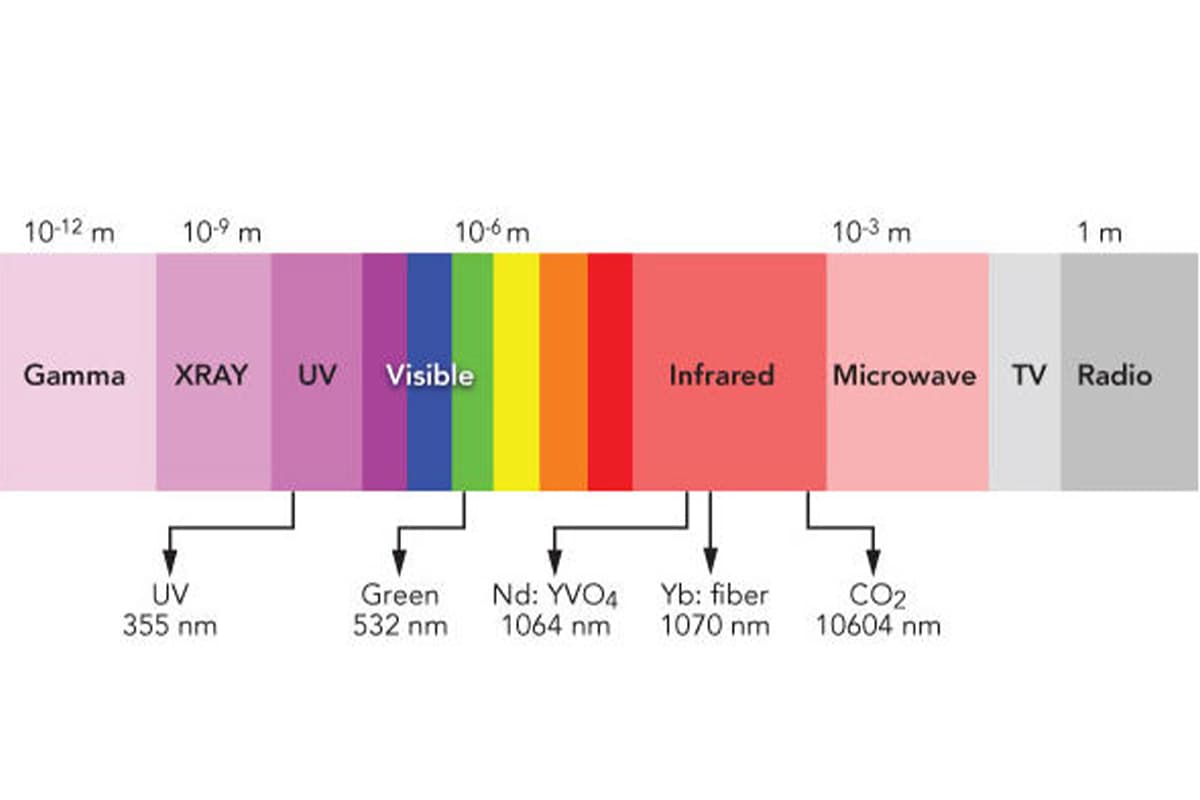
Infrared radiation, the most common radiation type in laser cutting, is electromagnetic radiation whose wavelength is longer than visible light. The common wavelength ranges from 700 nanometers to 1 millimeter.
This type of radiation can be absorbed by the human body and transformed into thermal energy. Therefore, long-time exposure to high-intensity infrared radiation may burn.
Generating approach:Â it is mainly produced by the material being heated by the laser beam. In a CO2 laser, the current transmits the gas mixture (mainly carbon dioxide, nitrogen, and helium), then inspires carbon dioxide molecules. When those molecules return to their basic states, the infrared photons will be released. At the same time, fiber laser adopts the fiber doped with rare earth elements (such as ytterbium and erbium), these elements can also release infrared photons via inspiring the optical pumping technology.
Application:Â infrared radiation has high energy density and a good ability to focus, which is suitable for high-precision manufacturing, such as cutting, welding, and marking.
Ultraviolet Radiation
Ultraviolet radiation is electromagnetic radiation whose wavelength is shorter than visible light. Its wavelength ranges from 10Â nanometers to 400 nanometers, which appears in specific situations. This ultraviolet radiation can be absorbed by the human body, resulting in sunburn and eye damage.
Generating approach: this type of radiation is generated by the laser itself. The ultraviolet laser (like excimer laser and solid-state laser) forms ultraviolet light via different lasing media and technologies. Excimer laser generates ultraviolet light by utilizing the gas mixture in a high-energy electric field, while the solid-state laser transforms the infrared light or visible light into ultraviolet radiation.
Application:Â owing to its shorter wavelength, ultraviolet radiation can achieve extremely high cutting precision and minimal heated affected zone, suitable for micromachining and high-precision marking.
Visible Light Radiation
Visible light is electromagnetic radiation with wavelengths between 400 nanometers and 700 nanometers, which is detectable by the human eye.
It is commonly emitted by certain types of lasers and appears in specific contexts during laser cutting processes. While less harmful than ultraviolet radiation, direct exposure can still cause damage to the eyes.
Generating approach: visible light is generated by lasers such as diode lasers or certain fiber lasers. These lasers use different lasing media to produce light in the visible spectrum. Diode lasers, for example, generate visible light by electrically exciting semiconductor materials, while fiber lasers emit visible light by utilizing doped optical fibers and specific pumping techniques.
Application: due to its ability to be precisely controlled, visible light is widely used in various applications such as engraving, precision cutting, and medical laser treatments. The visibility of the laser beam allows for better control and alignment in cutting and marking processes, making it valuable in industries requiring fine detailing.
Thermal Radiation (Heat)
Thermal radiation is the emission of heat energy in the form of infrared radiation, generated when materials are heated during laser cutting. The heat is a byproduct of the laser's interaction with the workpiece, causing localized melting, vaporization, or combustion.
Generating approach: this type of radiation is generated as a direct result of the laser beam interacting with the material being cut. When the laser delivers concentrated energy to a specific spot, it raises the temperature of the material, causing it to emit thermal radiation. This heat is a byproduct of energy absorption, especially when cutting metals or Other high-temperature-resistant materials.
Application: thermal radiation is a crucial aspect of the cutting process, as it enables the melting or vaporization of materials such as metal, wood, or plastic. It is essential in industrial cutting, welding, and drilling processes, allowing precise and controlled material removal or joining by melting edges and surfaces.
Secondary Ionizing Radiation
Secondary ionizing radiation refers to radiation such as X-rays that can be generated as a byproduct of laser cutting, particularly when high-powered lasers interact with metals or other materials. This type of radiation can ionize atoms or molecules in its path, which can pose safety risks.
Generating approach: this type of radiation is created when high-energy laser beams, especially from powerful industrial lasers, interact with certain materials, such as metals, and cause the emission of secondary radiation. The interaction between the laser photons and the material's atomic structure can produce ionizing radiation, typically in small quantities.
Application: while not commonly utilized for practical applications, secondary ionizing radiation must be monitored in environments where high-powered laser cutting is employed, especially in aerospace or nuclear industries where precision metal cutting may induce X-ray generation. Safety shielding and monitoring are critical to protect operators from potential exposure.
Fumes and Plasma Radiation
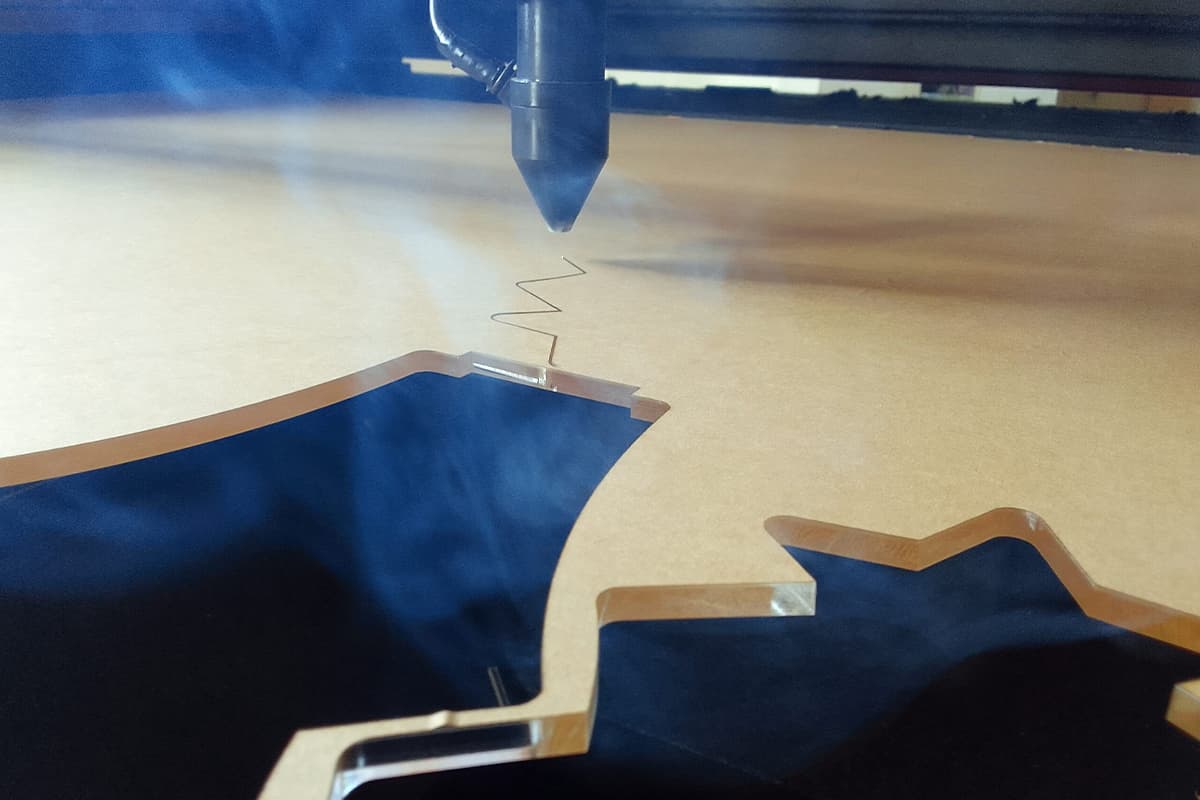
Fumes and plasma radiation are generated during the laser cutting process as byproducts of material vaporization and the creation of plasma when the laser interacts with certain metals.
Plasma radiation includes light, UV, and other energetic emissions, while fumes consist of vaporized materials and particulates.
Generating approach: plasma radiation and fumes are produced when high-powered lasers heat materials to the point of vaporization, creating a plasma—a highly ionized gas. This plasma emits various forms of electromagnetic radiation, including ultraviolet and visible light. Fumes are generated when the intense heat causes materials to vaporize and release particulates and gases into the air.
Application: plasma radiation is essential in processes like plasma cutting, which relies on ionized gas to cut through electrically conductive materials. Fumes are a byproduct of many laser-cutting processes, particularly when working with metals, plastics, or organic materials. Proper fume extraction systems are necessary to maintain air quality and ensure operator safety, particularly in industrial environments.
Non-ionizing Radiation
Non-ionizing radiation refers to the radiation type whose energy is insufficient to ionize atoms, including infrared radiation, visible light, and part of ultraviolet radiation.
Definition:Â because non-ionizing radiation will not destroy the electronic structure of atoms, it causes little direct damage to the environment and the human body.
Influence:Â although non-ionizing radiation will not cause ionizing damage, high-intensity laser radiation still causes damage to the skin and eye. Therefore, the proper protective measures should be taken during the laser cutting machine operation, such as wearing protective glasses and protective clothes.
Environmental influence:Â the smoke and particles produced during laser cutting may affect the environment. Therefore, an effective exhaust and filter system is needed to reduce pollution.
Comparison Between Ionizing and Non-ionizing Radiation
| Aspect | Ionizing Radiation | Non-Ionizing Radiation |
| Energy Level | High; can ionize atoms | Lower; cannot ionize atoms |
| Types | Gamma rays, X-rays, alpha and beta particles | Radio waves, microwaves, infrared, visible light |
| Sources | Cosmic rays, radioactive decay, X-ray machines | Sunlight, microwaves, radio transmitters |
| Health Effects | Can cause cancer, genetic damage, radiation sickness | Can cause burns, skin cancer from UV exposure |
| Protection Needs | Requires significant shielding and safety measures | Generally requires less protection, focus on avoiding high-intensity exposure |
IV. Health Impacts of Laser Cutting Machine Radiation
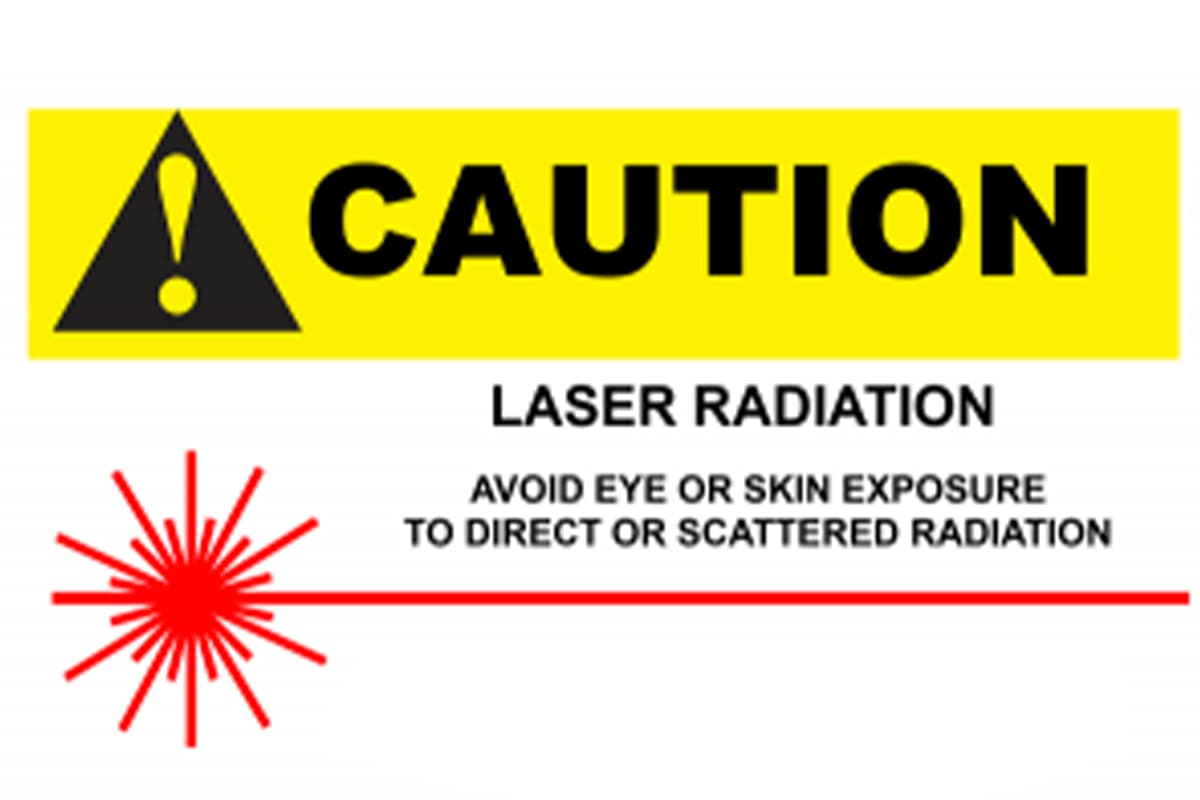
Potential Effects on Skin and Eyes
Laser cutting machines emit high-intensity light radiation that can have significant impacts on human health, particularly affecting the skin and eyes. The skin is vulnerable to both thermal and photochemical damage.
Direct exposure to laser beams can cause burns, leading to tissue damage of varying severity, and repeated exposure might accelerate skin aging or trigger other dermatological conditions.
The eyes are especially sensitive to laser radiation. Depending on the laser's wavelength and intensity, different parts of the eye can be affected.
For instance, exposure to ultraviolet (UV) and visible light lasers can damage the cornea and lens, potentially causing conditions such as photokeratitis (akin to a sunburn on the cornea) or cataracts. Infrared (IR) lasers, on the other hand, can affect the retina, leading to permanent damage and possible vision loss.
Even diffuse reflections from high-power lasers can pose significant eye hazards. Proper eye protection is critical to mitigate these risks, typically involving the use of specialized laser safety goggles designed for specific wavelengths.
Short-Term and Long-Term Exposure Risks
Short-term exposure to laser radiation primarily results in acute injuries such as burns on the skin and temporary flash blindness or retinal burns in the eyes. These injuries may require immediate medical attention to prevent long-term damage.
Users must be aware of the potential for these immediate effects to ensure safety protocols are rigorously followed, including the use of barriers and proper safety equipment.
Long-term exposure risks are of considerable concern as well. Chronic exposure to laser radiation, even at lower intensities, can have cumulative effects. Prolonged exposure increases the risks of developing chronic skin conditions, deteriorating vision, and other persistent health issues.
For instance, continuous exposure to low-level laser radiation might contribute to premature skin aging or an elevated risk of skin cancer. Long-term retinal exposure, even at low levels, can lead to progressive vision impairment over time.
V. Safety Measures
Ensuring the safe operation of laser-cutting machines necessitates the implementation of comprehensive safety measures and adherence to best practices.
These steps are critical in mitigating the risks associated with the various types of radiation emitted by these machines and safeguarding operators against potential health hazards.
Engineering Controls
- Laser Enclosures and Barriers: One of the most effective ways to prevent accidental exposure to laser radiation is to use physical barriers or enclosures. These should be designed to contain the beam within a confined area, preventing stray radiation from reaching unintended zones. Enclosures should be robust and capable of withstanding the machine's full power output to ensure absolute containment.
- Beam Path Control: Managing the beam path with precise mechanisms such as beam shutters, beam dumps, and automatic interlock devices ensures that the laser is only active when necessary and directed at the intended target. This reduces the risk of unintended exposure.
- Ventilation and Filtration: Implementing high-efficiency particulate air (HEPA) filters and activated carbon filters in the ventilation systems helps capture harmful particulates and fumes generated during the cutting process. Proper ventilation ensures that clean air circulates in the workspace, reducing inhalation risks.
- Cooling Systems: Effective cooling systems are vital in managing the heat produced during laser cutting. These systems help prevent thermal radiation-related injuries and avoid overheating of materials, which can lead to fires.
- Safeguarding Electronics: Electromagnetic radiation can interfere with nearby electronic equipment, leading to malfunctions. Shielding sensitive electronics and maintaining adequate spacing between laser cutting machines and critical machinery help mitigate these risks.
Administrative Controls
- Access Control: Limiting access to areas where laser cutting machines are used to trained and authorized personnel significantly reduces the risk of accidental exposure. This can be enforced through keycards, biometric systems, and monitored entry points.
- Regular Maintenance and Inspection: Conducting regular maintenance checks and inspections ensures that all safety equipment, such as barriers and interlocks, are functioning correctly. Regular calibration of the laser and its components helps maintain optimal performance and safety standards.
- Safety Training: Comprehensive training programs for operators and maintenance personnel are essential. These should cover the correct usage of the laser cutting machine, understanding the types of radiation emitted, the significance of each safety measure, and the proper use of personal protective equipment (PPE).
Personal Protective Equipment (PPE)
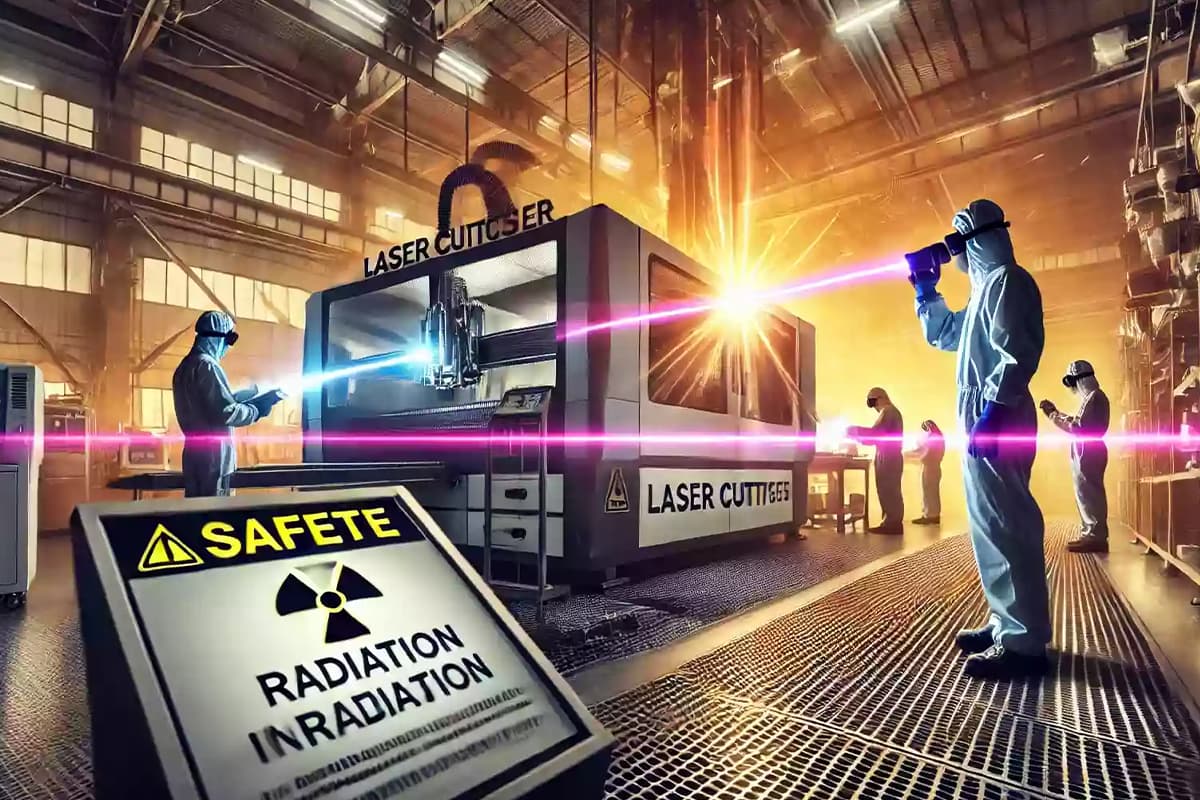
- Laser Safety Glasses: Operators must wear safety glasses that provide adequate protection against the specific wavelength of the laser in use. The glasses' optical density (OD) should be chosen based on the laser's power to ensure maximum protection.
- Flame-Retardant Clothing: Wearing flame-retardant clothing minimizes the risk of burns from laser radiation and hot materials. Protective gloves and aprons can offer additional protection for hands and bodies.
- Respiratory Protection: In environments with potential exposure to toxic fumes and particulates, appropriate respiratory PPE, such as masks or respirators, must be used. Respiratory protection is particularly critical when cutting materials known to emit hazardous fumes.
VI. Laser Classifications and Safety Standards
Overview of Laser Classification (Class 1, 2, 3R, 3B)
Laser classification is a critical aspect of laser safety, providing a framework to categorize lasers based on their potential hazard levels. This classification system helps users understand the inherent risks and implement appropriate safety measures.
The most widely recognized classification system defines lasers into four main classes—Class 1, 2, 3R, and 3B—each with specific safety implications.
- Class 1: These are the safest lasers, incapable of causing harm under normal operating conditions. They are often enclosed systems where the laser is physically constrained from human access during operation. Examples include laser printers and CD players.
- Class 2: Class 2 lasers emit visible light and have low power, generally up to 1 milliwatt (mW). Their primary hazard is to the eyes; however, the blink reflex (an involuntary response to bright light) provides protection for brief exposures. Examples include laser pointers and some alignment tools.
- Class 3R: Formerly known as Class 3a, these lasers operate at slightly higher power levels up to 5 mW. Direct eye exposure can be potentially hazardous, but the risk remains low under controlled use conditions. Users need to avoid prolonged viewing and apply caution with alignment.
- Class 3B: Class 3B lasers are more powerful, ranging from 5 mW up to 500 mW. They present significant eye hazards, both from direct exposure and diffuse reflections. Eye protection is mandatory, and proper safety measures, such as beam enclosures and interlocks, should be employed to prevent accidental exposure. Industrial laser cutting and medical laser treatment devices often fall into this category.
Discussion of IEC and CDRH Standards
The International Electrotechnical Commission (IEC) and the Center for Devices and Radiological Health (CDRH) are two leading organizations that set standards for laser safety, ensuring a standardized approach to classifying and handling laser devices.
- IEC Standards: The IEC standard, specifically IEC 60825, provides guidelines for the safe use of lasers, encompassing classification, labeling, and safety measures. This standard is globally recognized and widely adopted in numerous industries. IEC 60825-1 is particularly pivotal in outlining laser classifications and user safety requirements. It specifies the necessary engineering and administrative controls to mitigate risks associated with laser use, from consumer devices to industrial-grade lasers.
- CDRH Standards: The CDRH, a branch of the U.S. Food and Drug Administration (FDA), regulates the sale and usage of laser products in the United States. The CDRH's standards are codified in the Code of Federal Regulations (CFR), Title 21, Part 1040.10 and 1040.11. These regulations enforce stringent safety requirements, including performance standards, warning labels, and user manuals. The CDRH standards emphasize protecting users and the public by ensuring that laser products meet specific safety criteria before they can be marketed.
VII. FAQ
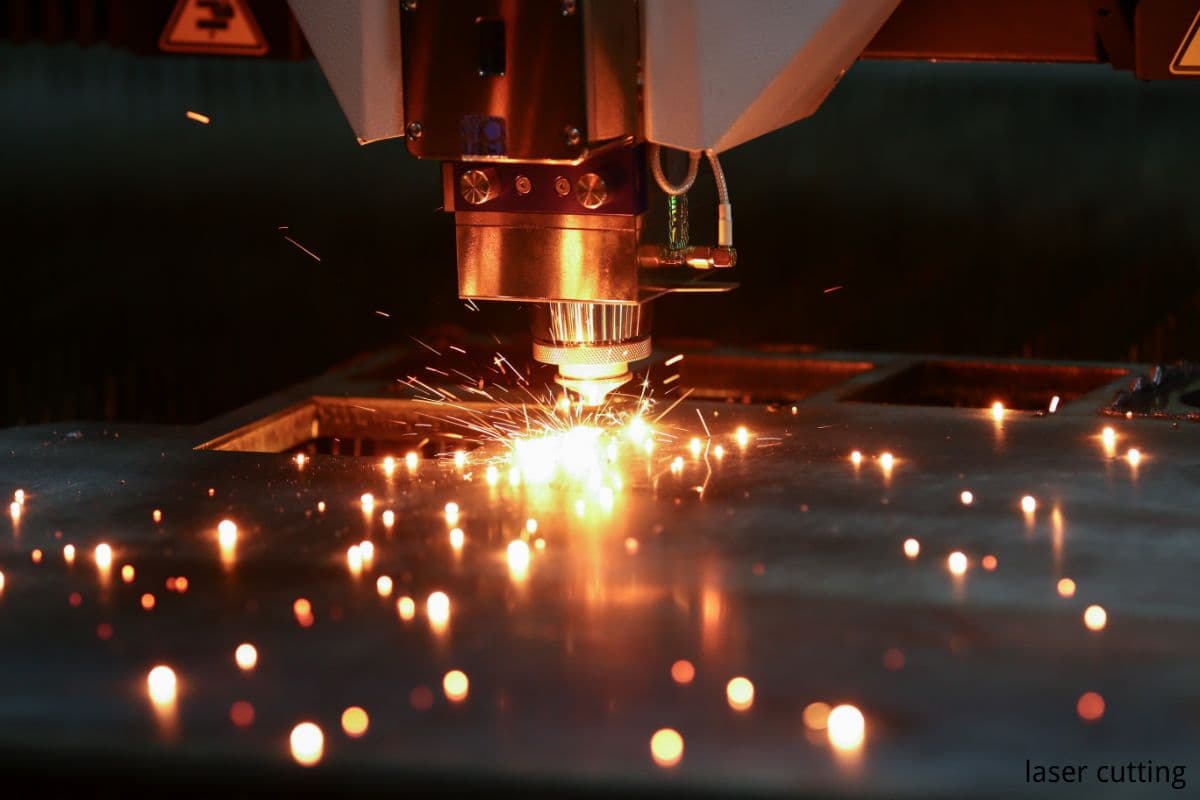
1. What are the primary types of lasers used in cutting machines?
The principal types of lasers utilized in cutting machines encompass CO2 lasers, fiber lasers, and Nd: YAG lasers. CO2 lasers operate in the infrared spectrum, offering deep thermal penetration, and are highly effective for cutting non-metallic materials such as wood and plastic.
Fiber lasers, known for their high efficiency and power density, are particularly suited for cutting metals and deliver excellent precision for intricate designs. Nd: YAG lasers utilize neodymium-doped yttrium aluminum garnet crystals and are versatile, handling both cutting and welding tasks efficiently.
2. How does laser radiation differ from other types of electromagnetic radiation?
Laser radiation is distinct due to its coherence, monochromaticity, and high collimation. Unlike other forms of electromagnetic radiation, laser light consists of waves that are in phase, producing a highly directional and focused beam.
This precision allows for exact energy application, achieving superior cutting accuracy compared to broader-spectrum radiation sources like traditional light or infrared heaters. As a result, laser cutting minimizes material distortion and enhances cutting quality.
3. Can laser radiation cause long-term health effects?
Yes, prolonged exposure to laser radiation can result in significant long-term health effects. Repeated exposure to UV radiation can accelerate skin aging and increase the risk of skin cancer.
Optical hazards are also prominent; chronic exposure to visible or infrared laser radiation can lead to permanent retinal damage and cataracts, hampering vision. Therefore, it is crucial to adhere to strict safety guidelines, including the use of protective eyewear, proper shielding, and regular use of PPE.
Api Pup And Joint 2-7/8,2-7/8 Nu/eu Coupling,Pup Joint Coupling 2-7/8
Henan Dongfanglong Trade Co.,Ltd , https://www.tjdflpetro.com